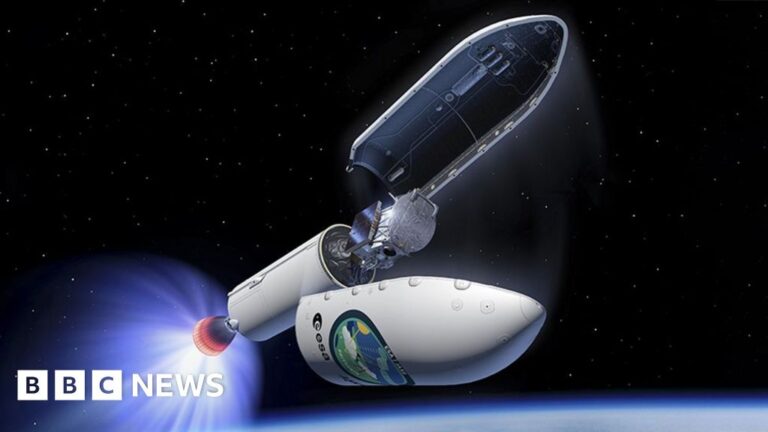An advanced European-Japanese satellite has been launched to measure how clouds affect the climate.
It is known that some low-level clouds cool the Earth, while some high-altitude clouds act like a blanket.
The EarthCare mission will use lasers and radar to probe the atmosphere to find out exactly where the balance is.
This is one of the big uncertainties in the computer models used to predict how the climate will respond to increasing greenhouse gases.
“Many of our models suggest that cloudiness will decrease in the future, which means that clouds will reflect less sunlight back into space and more will be absorbed by the Earth’s surface, which will act to amplify carbon dioxide-induced warming,” Dr Robin Horgan, from the European Centre for Medium-Range Weather Forecasts, told BBC News.
The 2.3 tonne satellite was launched from California on a SpaceX rocket.
The project is being led by the European Space Agency (ESA), which describes it as its most complex Earth observation undertaking to date.
Indeed, the technical challenges to making the equipment work as intended were enormous: it took 20 years from mission approval to launch.
Earthcare will orbit the Earth at an altitude of about 400 km (250 miles).
There are actually four instruments in total that work together to get the information climate scientists want.
The simplest is the imager, a camera that takes pictures of the scene as it passes beneath the spacecraft and provides background information for measurements made by the other three instruments.
Earthcare’s European UV laser observes thin altostratus and lower cloud tops, and also detects tiny particles and droplets in the atmosphere (aerosols) that affect cloud formation and behaviour.
Japanese radar looks inside the clouds to determine how much water they contain and how it falls as rain, hail or snow.
And radiometers sense how much of the energy hitting Earth from the Sun is reflected or radiated back into space.
“The balance between the total amount of radiation coming out and the amount of radiation coming in from the sun fundamentally determines climate,” said Dr Helen Brindley from the UK’s National Earth Observation Centre.
“If you change that balance, for example by increasing the concentrations of greenhouse gases, you reduce the amount of energy going out relative to the energy coming in, and the climate warms.”
EarthCare data will be used to improve current weather forecasts as well as long-term climate projections: the way storms develop, for example, is influenced by the initial cloud conditions observed by satellites several days in advance.
The original scientific concept of Earthcare was proposed in 1993 by Professor Anthony Illingworth and his colleagues at the University of Reading.
He said it was a dream come true to finally see the satellite take flight. “It’s been a long and difficult journey with a fantastic team of dedicated scientists and engineers from the UK and abroad. Together we’ve built something truly incredible that will change our understanding of Earth.”
One of the key technical challenges was the space laser, or lidar.
Its developer, Airbus France, struggled to arrive at a design that would work reliably in the vacuum of space, necessitating a radical reconfiguration of the equipment, which not only caused delays but also significantly increased the final cost of the mission, now valued at around €850m (£725m).
“These aren’t cheap, quick missions to solve small problems. This is complex stuff. The reason Earthcare has taken so long is because we are aiming for the highest standards,” said Dr Beth Greenaway, head of Earth observation at the UK Space Agency.
It won’t take long for EarthCare to gather data. Flying at an altitude of 400km means that the satellite will experience resistance from the residual atmosphere at that altitude, which will pull it down.
“The satellite has three years’ worth of fuel, with another year’s reserve fuel – its lifetime is basically limited by low Earth orbit and the drag there,” said ESA’s Dr Michael Eisinger.
Industrial development of Earthcare was led by Germany’s Airbus, and the basic chassis, or structure, of the spacecraft was manufactured in the UK. The UK also supplied the radiometer from Thales Alenia Space UK and the imaging equipment from Surrey Satellite Technology. GMV-UK provided the ground systems which processed all the data.
The Japanese space agency (JAXA) has taken such an interest in the mission that, as is customary, it plans to nickname the spacecraft “Hakuryu” (White Dragon).
In Japanese mythology, the dragon is an ancient, sacred creature that rules the waters and flies through the sky. This year, 2024, is also the Japanese Year of the Dragon, known as “Tatsunen.”
The satellite’s appearance is also relevant, as it is covered in white insulation and has a long, dangling solar panel like a tail.
“Earthcare will be like a dragon rising into space, envisioning our future,” said Eiichi Tomita, a JAXA project manager.

